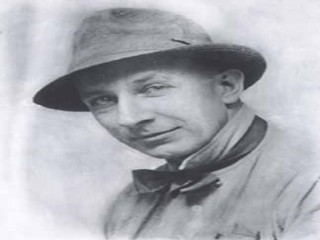
George Bellows biography
Date of birth : 1882-08-19
Date of death : 1925-01-08
Birthplace : Columbus, Ohio, U.S.
Nationality : American
Category : Arts and Entertainment
Last modified : 2011-05-12
Credited as : Artist painter, American scene,
George Wesley Bellows was a prolific and accomplished leader among American painters who approached representation of the American scene realistically.
George Bellows was born in Columbus, Ohio, on Aug. 19, 1882. At Ohio State University (1901-1904) he distinguished himself as an athlete, but he determined that he wanted to be an artist and went to New York City in 1904 without graduating. For a time he supported himself as a professional athlete. He studied at the New York School of Art under Robert Henri, who became an influential and lifelong friend.
Bellow's early paintings are swift and vivid character studies, of somber tonality. His development was very rapid, and from 1906 on his works were accepted in national exhibitions. He was fascinated with the spectacle of the great city: its buildings, crowds, types, and rivers. Though he was denounced by conservative critics as one of the "apostles of ugliness, " his technical brilliance made him more acceptable than any of the other painters of similar impulse. He became an associate of the National Academy of Design at the age of 27, the youngest person ever so honored, and was elected a full academician 4 years later. His work is marked by exuberance, variety of subject matter, humor, and vitality, always depicted with gusto.
In 1907 Bellows produced the first of several paintings of prizefighters in action in the ring; these expressed violent action with power and seeming spontaneity. He married in 1910, rebuilt an old house on 19th Street, and started his teaching career at the Art Students League. He was a teacher of the Henri variety—bringing out the individuality of each student with excitement and imagination. He spent several summers in Maine, where he painted windswept landscapes and sea scenes. In the summer of 1912 Bellows visited California and New Mexico—his only excursion to the Far West. He never went to Europe.
Bellows was well represented in the important Armory Show of 1913. The new European movements exhibited there may have had an unsettling influence on him, as they did on many progressive American painters who discovered that their innovations had been in subject matter rather than in method or form. In 1916 Bellows turned to lithography (at this time seldom used by serious artists) because its immediacy attracted him, His nearly 200 lithographs deal with a wide variety of subjects—genre scenes, nudes, portraits, landscapes, literary illustrations, and humorous or satiric commentaries. He was deeply and emotionally affected by World War I and recorded his reactions in a series of powerful and painful prints that have been compared with those of Goya. In 1918 he became interested in Jay Hambidge's theory of dynamic symmetry, which provided a geometric system of composition for controlling the artist's work. Hambidge (and Bellows) believed it was followed by many of the great artists of antiquity.
Bellows taught at the Chicago Art Institute in 1919; his sojourn there was remembered as a whirlwind of enthusiasm and activity. His illustrations for novels by Don Byrne and H. G. Wells (1921-1923) are rich in action, characterization, and imagination. Bellows's finest late works are undoubtedly the portraits of his wife, two small daughters, mother, and aunt. Brilliantly painted, with solid structural design and probing characterization, they are among the triumphs of American realism, legitimate successors to the best works of Thomas Eakins. Less successful are some of the late landscapes, which tend to be mannered in style and lurid in color, and the large Crucifixion, his only religious work.
A neglected attack of appendicitis caused Bellows's death on Jan. 8, 1925, in New York.
















